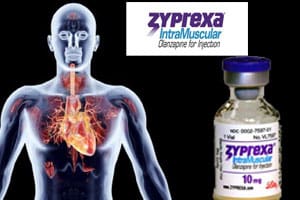
A recent study has found that some antipsychotic drugs were associated with increased risks for developing torsade de pointes (TdP), a type of abnormal heart rhythm, and other adverse events. Zyprexa was among the drugs studied. For their research, the scientists used the U.S. Food and Drug Administration’s (FDA) Adverse Events Reporting System (FAERS) database […]
 A recent study has found that some antipsychotic drugs were associated with increased risks for developing torsade de pointes (TdP), a type of abnormal heart rhythm, and other adverse events. Zyprexa was among the drugs studied.
A recent study has found that some antipsychotic drugs were associated with increased risks for developing torsade de pointes (TdP), a type of abnormal heart rhythm, and other adverse events. Zyprexa was among the drugs studied.
For their research, the scientists used the U.S. Food and Drug Administration’s (FDA) Adverse Events Reporting System (FAERS) database to understand the safety signals related to antipsychotic medications, according to Drug Safety Monitor.
The adverse events chosen for review included TdP, QT-interval abnormalities, ventricular fibrillation and tachycardia, and sudden cardiac death. Three antipsychotic drugs were associated with these specific adverse events: amisulpride, Tercian (cyamemazine), and Zyprexa (olanzapine). Of the adverse events seen, 25 related to amisulpride and 11 were related to Tercian; 189 were associated with Zyprexa, said Drug Safety Monitor. Zyprexa is the only drug studied that has been approved for use in the United States.
The team concluded that the review revealed potential safety signals that had not been previously seen in pharmacovigilance, according to Drug Safety Monitor.
Zyprexa, considered a second-generation antipsychotic that was approved by the FDA in 1996 for the treatment of schizophrenia, the acute treatment of manic or mixed episodes associated with bipolar 1 disorder, and maintenance treatment of bipolar 1 disorder. Eli Lilly and Company markets Zyprexa, noted the Drug Safety Monitor.
FAERS data, obtained from November 1, 1997 through August 27, 2012, were, according to the Drug Safety Monitor, aggregated and standardized by the AdverseEvent RxFilter process. The team identified 450 cases of QT interval abnormalities, 41 cases of torsade de pointes, 2,971 cases of cardiac arrhythmia, and 943 instances of cardiac death in which Zyprexa was indicated as a suspect drug.
We’ve written that prolongation of the QT interval involves changes to the electrical activity of the heart and can lead to an abnormal heart rhythm—including Torsade de Pointes—which can be fatal. Patients at particular risk for developing prolongation of the QT interval include those with underlying heart conditions and those who are predisposed to low levels of potassium (hypokalemia) and magnesium (hypomagnesemia) in the blood.
Prior research indicates that newer antipsychotic drugs, such as Zyprexa, are no better than older and cheaper drugs in this class for the treatment of schizophrenia, yet most of the adults in the United States—about 75 percent—who are treated with these drugs are prescribed second generation antipsychotics, which were developed in the hopes that patients would experience less of the side effects that are seen in older generation medications such as Thorazine (chlorpromazine) and Haldol (haloperidol). There is also a huge cost difference between first- and second- generation antipsychotics in terms of price. For instance, a one-month supply of Zyprexa can cost about $546, while Haldol costs $18-$27 per month, according to Consumer Reports’ data.
Longer-tem antipsychotic risks may include diabetes; major metabolic syndrome; and a neurological disorder that causes tardive dysinesia (involuntary, repetitive movements).


